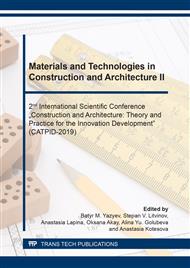p.288
p.293
p.299
p.305
p.312
p.319
p.325
p.331
p.336
Mathematical Simulation of Bottom Ash Effect and Expanded Polystyrene on the Polystyrene Concrete Properties
Abstract:
Nowadays various light concrete types have many advantages as compared to heavyweight concrete (total structures mass decrease, increased thermophysical properties, less material consumption). Various industrial wastes use such as fly ashes, slag and bottom ash was suggested to enhance the light concretes effectiveness. This is greatly important for a green light concrete production since it is very important to obtain new types of environmentally friendly materials using wastes. The article substantiates the light concrete use and creation with organo-mineral additives based on industrial waste, analysis of the second-order mathematical model describing the bottom ash (BA) amount effect of Vung Ang TPP and expandable polystyrene spheres (EPS) on the light concrete density and compressive strength at the age of 28 days of normal hardening is done. In this work, the BA and EPS amounts varied from 14.5 to 45.5%, respectively, of the cement weight and from 24.5 to 55.5% of the concrete mix volume. The effect of expanded polystyrene spheres (EPS) and bottom ash (BA) TPP "Vung Ang" amounts as the input parameters on the polystyrene concrete properties (PCP) were investigated in this study. On the one hand, various proportions of BA (14.5, 20, 30, 40 and 45.5%) were blended in concrete mixes as partial weight replacement for Portland cement. On the other hand, EPS amount was replaced by the fresh concrete volume in the range from 24.5% to 55.5%. Additionally, the central composite design method of Box-Wilson for second order factors was used to predict the EPS and BA effects on the polystyrene concrete properties. The results showed that the proposed regression equations of this mathematical model achieved an adequate prediction accuracy. Hence, the effects of both bottom ash contents and expanded polystyrene spheres on the dry density and 28-day compressive strength of the PSC-specimens were significant. In the future, further investigations have to be carried out to study the quality prediction of green light concrete containing various wastes.
Info:
Periodical:
Pages:
312-318
Citation:
Online since:
December 2019
Authors:
Price:
Сopyright:
© 2020 Trans Tech Publications Ltd. All Rights Reserved
Share:
Citation:


